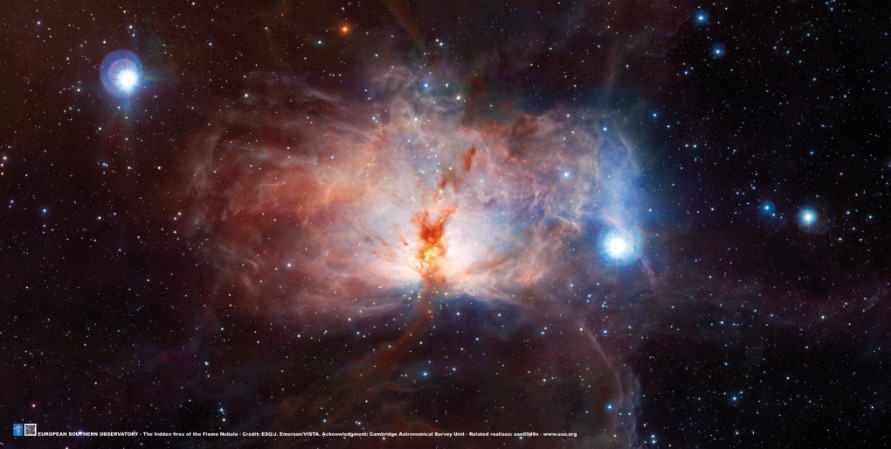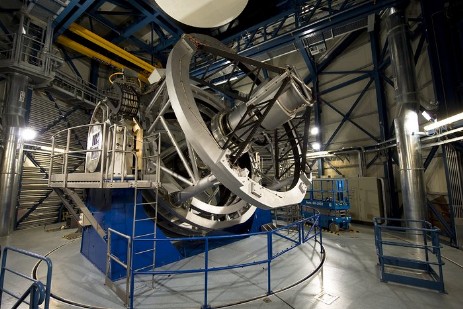Gli "incendi nascosti"
nella Nebulosa
della Fiamma
Questa immagine del telecopio a raggi infrarossi VISTA, mostra la spettacolare regione di formazione di stelle conosciuta come la nebulosa della fiamma, nella costellazione di Orione e dintorni. Nelle viste di questo oggetto evocativo in luce visibile, il nucleo della nebulosa è completamente nascosto dietro l'oscurità della polvere, ma in questa nuova visione VISTA, presa con la luce ad infrarossi, viene rivelato il cluster di stelle molto giovani nel cuore dell'oggetto.
The hidden fires of the Flame Nebula
This VISTA infrared telescope image shows the spectacular star-forming region known as the Flame Nebula, or NGC 2024, in the constellation of Orion (the Hunter) and its surroundings. In views of this evocative object in visible light the core of the nebula is completely hidden behind obscuring dust, but in this VISTA view, taken in infrared light, the cluster of very young stars at the object’s heart is revealed.
Crediti: ESO/J. Emerson/VISTA. Acknowledgment: Cambridge Astronomical Survey Unit

La Nebulosa della Fiamma
Si tratta di una grande regione H II visibile poco ad est della brillante Alnitak; la sua caratteristica fisica principale, che le conferisce pure il nome, è una grande banda scura di polveri che l'attraversa da nord a sud, allargandosi progressivamente e conferendo alla parte brillante della nebulosa una forma a fiamma; la sorgente illuminante non è, come potrebbe sembrare, Alnitak, poiché questa stella si trova a circa 820 a.l.
Crediti: ESO/J. Emerson/VISTA. Acknowledgment: Cambridge Astronomical Survey Unit
Flame Nebula
The Flame Nebula, designated as NGC 2024 and Sh2-277, is an emission nebula in the constellation Orion. It is about 900 to 1,500 light-years away. The bright star Alnitak (ζ Ori), the easternmost star in the Belt of Orion, shines energetic ultraviolet light into the Flame and this knocks electrons away from the great clouds of hydrogen gas that reside there. Much of the glow results when the electrons and ionized hydrogen recombine. More info...
Credits: ESO/J. Emerson/VISTA. Acknowledgment: Cambridge Astronomical Survey Unit
Telescopio VISTA
Telescopio astronomico per survey nell'ottico e vicino infrarosso (o Visible and Infrared Survey Telescope for Astronomy in inglese) ― fa parte dell'Osservatorio del Paranal. VISTA lavora a lunghezze d'onda del vicino infrarosso ed è il più grande telescopio per survey al mondo. Il grande specchio, l'ampio campo di vista e i rivelatori molto sensibili ci daranno una visione completamente nuovo del cielo australe. VISTA ha uno specchio principale di 4,1 metri di diametro. In termini fotografici può essere pensato come una macchina fotografica di 67 megapixel con una lente da 13 000 mm a f/3.25. Per saperne di più...
VISTA Telescope
The Visible and Infrared Survey Telescope for Astronomy ― is part of ESO’s Paranal Observatory. VISTA works at near-infrared wavelengths and is the world’s largest survey telescope. Its large mirror, wide field of view and very sensitive detectors are revealing a completely new view of the southern sky. VISTA has a main mirror that is 4.1 metres across. In photographic terms it can be thought of as a 67 megapixel digital camera with a 13 000 mm f/3.25 mirror lens. More info...
Osservatorio Paranal: L'osservatorio del Paranal è un osservatorio astronomico situato sul Cerro Paranal, nel deserto di Atacama (120 km a sud di Antofagasta, in Cile, 1200 km da Santiago), realizzato e gestito dall'European Southern Observatory. Il Cerro Paranal è una montagna alta 2635 metri, situata a 12 km dalla costa sull'oceano Pacifico, che si trova in una delle zone più secche di tutto il pianeta.. Per saperne di più... Image Credit: ESO
Paranal Observatory: is an astronomical observatory operated by the European Southern Observatory (ESO); it is located in the Atacama Desert of northern Chile on Cerro Paranal at 2,635 m (8,645 ft) altitude, 120 km (70 mi) south of Antofagasta. By total light-collecting area, it is the largest optical-infrared observatory in the Southern hemisphere; worldwide, it is second to the Mauna Kea Observatory on Hawaii. More info... Image Credit: ESO
Sistema Solare Interno Mercurio Venere Terra | Sistema Solare Esterno | Via Lattea | Universo Supernova Extragalattiche |
Prenota la mostra per i tuoi eventi (da novembre 2017) | |||




































